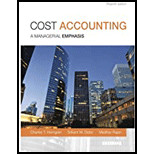
1.
Cost-Volume-Profit Analysis (CVP Analysis):
CVP Analysis is a tool of cost accounting that measures the effect of variation on operating profit and net income due to the variation in proportion of sales and product costs.
Operating Income:
Operating income is the revenue generated from the routine course of business operations. Alternatively operating income can also be referred as the earnings before interest and taxes (EBIT) which is the sum total of income after deduction of operational expenses.
To compute: Contribution margin percentage, break-even point in revenue and degree of operating leverage.
2.
To compute: Advantages and disadvantages of each sales alternative.
3.
To compute: The revenue which is required to earn the operating income as year 2013.
Want to see the full answer?
Check out a sample textbook solution
Chapter 3 Solutions
EBK COST ACCOUNTING
- Please explain the solution to this general accounting problem with accurate explanations.arrow_forwardYour company purchases $6,200 of office supplies, recording them as assets. At year end, a physical count shows $1,800 of supplies on hand. The year-end adjusting entry debits Supplies Expense and credits Supplies on hand for $1,800. The correcting entry will _.arrow_forwardHow much profit (loss) does the company make by processing the intermediate product cane syrup into refined syrup rather than selling it as is?arrow_forward
- XYZ Industries manufactures premium-quality glassware. The standard materials cost is 4 pounds of raw glass at $2.25 per pound. During October, 18,000 pounds of raw glass costing $2.40 per pound were used to produce 7,200 glassware items. Determine the materials price variance and materials quantity variance.arrow_forwardHello tutor please help me this questionarrow_forwardHelp this best solution Accounting questionarrow_forward
- General Accounting Questionarrow_forwardSolve thisarrow_forwardMartinez Industries manufactures wood polish. The standard direct materials quantity is 0.70 pounds per bottle at a cost of $2.80 per pound. The actual usage for the production of 45,000 bottles was 0.75 pounds per bottle at an actual cost of $2.75 per pound. Calculate the direct materials price variance and the direct materials quantity variance.arrow_forward

 AccountingAccountingISBN:9781337272094Author:WARREN, Carl S., Reeve, James M., Duchac, Jonathan E.Publisher:Cengage Learning,
AccountingAccountingISBN:9781337272094Author:WARREN, Carl S., Reeve, James M., Duchac, Jonathan E.Publisher:Cengage Learning, Accounting Information SystemsAccountingISBN:9781337619202Author:Hall, James A.Publisher:Cengage Learning,
Accounting Information SystemsAccountingISBN:9781337619202Author:Hall, James A.Publisher:Cengage Learning, Horngren's Cost Accounting: A Managerial Emphasis...AccountingISBN:9780134475585Author:Srikant M. Datar, Madhav V. RajanPublisher:PEARSON
Horngren's Cost Accounting: A Managerial Emphasis...AccountingISBN:9780134475585Author:Srikant M. Datar, Madhav V. RajanPublisher:PEARSON Intermediate AccountingAccountingISBN:9781259722660Author:J. David Spiceland, Mark W. Nelson, Wayne M ThomasPublisher:McGraw-Hill Education
Intermediate AccountingAccountingISBN:9781259722660Author:J. David Spiceland, Mark W. Nelson, Wayne M ThomasPublisher:McGraw-Hill Education Financial and Managerial AccountingAccountingISBN:9781259726705Author:John J Wild, Ken W. Shaw, Barbara Chiappetta Fundamental Accounting PrinciplesPublisher:McGraw-Hill Education
Financial and Managerial AccountingAccountingISBN:9781259726705Author:John J Wild, Ken W. Shaw, Barbara Chiappetta Fundamental Accounting PrinciplesPublisher:McGraw-Hill Education





